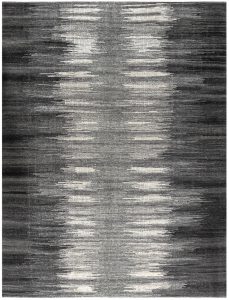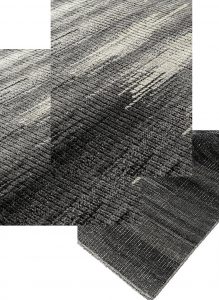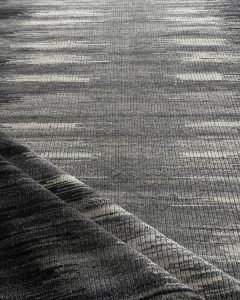Interesting Write Up On an Ikat Rug
This carpet, which can be ordered in custom sizes, is even more interesting than it looks! First, consider the high-low effect. Not just any high-low, but a ridged granularity following the warps. While the vast majority of old and new carpets knot on every warp, this unusual type leaves a center warp free between pairs of knots. We can see this clearly on the back where pairs of knots cover four warps but leave one continuous column uncovered. This result is a broad ribbing effect on the front, perpendicular to the rows of knots. Then there is abrash. Wow! All abrash. Traditionally abrash was an unintended effect produced when weavers changed same color yarn balls in the knotting process. Although, for example, two reds may have originally appeared similar, they came from distinctly different dye lots, and the variation became apparent as the rug aged, from contact with light and air, washing and any other adventitious processes. Succinctly, abrash developed over time and could be either positive or negative, producing a subtle color variation, say in the field, or something obnoxious and stripey.
Modern abrash, as shown here is different. It is not unplanned or accidental but happens by intent. Abrash can be created by wringing out the dye-wet hanks/skeins of yarn, creating areas that are more or less saturated with the dye. When dry and ready to employ in a rug, the wonderful color variety is displayed. The resulting abrash is intended, but still has a random character. We call this an “ikat” design, fully conscious that is a knot ikat, not a traditional warp or weft ikat as found in, among others, Central Asian silks. An ikat effect produced by knotting. A very attractive pseudo-ikat. The ikat effect can be varied with the knot density and we have less dense styles as well.
In this carpet style, it is all abrash, with a variation in the grey tones from charcoal to ash to flannel to battleship. And within each tone there are many others which become apparent only upon close looking. Here we have the darker greys migrating toward the sides, medium greys in a central column and lighter greys filling in. It has a look of symmetry, but the irregular comb-like tonal protrusions randomly lock the composition together. The progression on each line across is totally natural, from dark, to intermediate, to light and so on. There is order without plan. And no colors intrude. Fifty shades of grey? More like a hundred. This is not a rigidly supervised carpet where every knot has a fixed, immutable place, and imagination is not tolerated. We don’t have any conversations with the weavers, of course, but it seems that they were given a general idea, balls of abrashed yarn, and told to go at it. We have this style custom available in various sizes, but no two examples are exactly alike, although they may share the general idea. When you order, you get comb interlocking, and virtually infinite abrash. And a textural high-low effect which recedes in visual prominence as the color darkens and comes out was the tonality lightens. Now you see it, now you don’t. The shadows generated by the high-low effect are more visible in the light areas and tend to vanish in the darker ones. But the actual ribbed effect remains, But only grey, please. Or greys.










